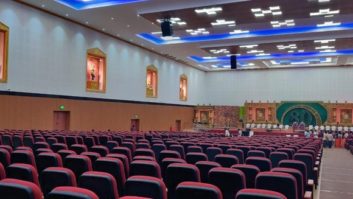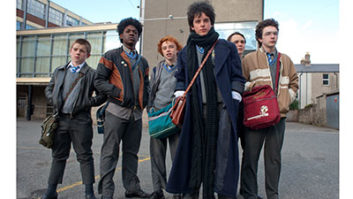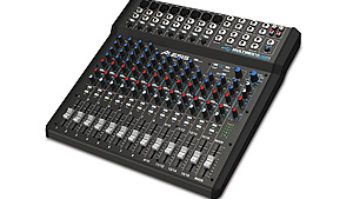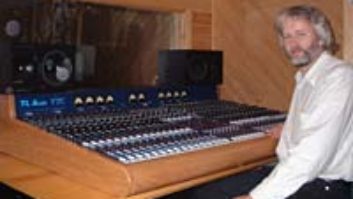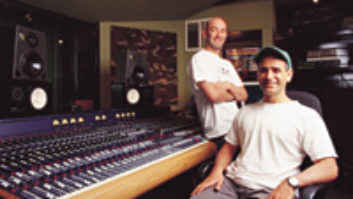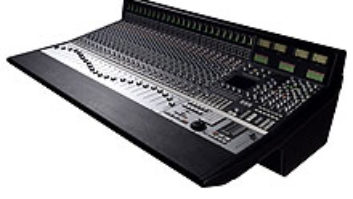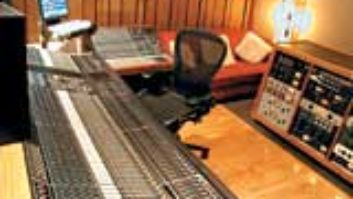Razor-blade editing, 1-inch, 8-track tape decks and real echo chambers have already gone the way of the dodo bird, yet British tube specialist TL Audio is now bucking the trend with the VTC Tube Console. Most American engineers, even a woolen-eared old vet like me, have never used a tube console, so I wanted to test-pilot the VTC to see what I have missed, if anything. It turns out that, just like using an outboard tube-based mic preamp, compressor or EQ, the VTC gives you that certain “tube something” — on every input channel, on every recording bus and at the stereo output.
The VTC is based around multiple 8-channel, steel-framed sections, each carrying its own power regulators, and is available in 16- to 56-channel configurations. Each section gets power and fully balanced audio signals from two multipin connectors on a large motherboard. All consoles have 8-bus outputs (not expandable) that can feed any number of recorder inputs, channel direct outputs and a separate stereo mixing bus. All external connections are by XLR or TRS jacks on the back of the console.
The VTC I reviewed at Westlake Audio, Los Angeles, is a 24-channel version measuring 11.8×46.5×50.4 inches wide (H×L×W) and was set up in a demo room, making it impractical to plug in a microphone and evaluate the mic preamps. The VTC is reportedly a popular recording console in several European Pro Tools studios, but, so far, no L.A. studios have installed this new console.
TL Audio refers to the VTC as a “hybrid,” because both tubes and integrated circuit chips are used throughout. ECC83/12AX7A tube amplifier stages are used in the channel strip, the Mix B preamp, tape return amplifier and the group (bus), as well as both the Mix B and stereo master mix paths. So when recording, the audio signal will pass through at least two tube stages and when mixing, up to three more tube stages.
The VTC uses the familiar “in-line” channel strip design. Starting at the top of the channel strip is the microphone input preamp consisting of an SSM 2017 chip feeding a 12AX7 stage with gain adjustable from 16 to 60 dB. There is a 90Hz/12dB-per-octave highpass filter next to a phase Flip button and +48-volt phantom power on/off. Another tube stage is used for the tape return preamp for its ±20dB trim control, and the channel strip’s routing can be changed with the channel/monitor Flip button.
Next are the six mono auxiliary send controls. Aux 1/2 have their own control, while 3/4 and 5/6 share a single switch-selectable knob. The stereo aux 7/8 send offers pre/post-switching, useful for both cue mixing and feeding stereo effects. Sends 3/4, 5/6 and 7/8 can be assigned to operate with the Mix B mixer if desired.
I found the VTC equalizer very good and musical with a wide selection of Q values and up to 15 dB of boost/cut. The equalizer is divided into a LF/HF section and two fully parametric midrange sections. Either sections (or both) can be assigned to the Mix B path. The LF/HF sections offer Baxendale shelving-type filters capable of ±15 dB at 12 kHz and 80 Hz. This section reminded me of the bass and treble tone controls on my dad’s old tube Magnavox hi-fi — very sweet. Also offering ±15 dB of boost/cut, the two midrange sections have variable Q control with a range of 0.8 to 7. LM (lower-mid) frequency range is 50 to 2k Hz, while the HM (high-mid) range is 500 to 18k Hz.
Right below the equalizer is the Mix B or Monitor Channel fader, a 60mm Alps model that provides an additional 10 dB of gain if necessary. There are Solo, Mute and center-detented Pan controls and two automation buttons called Auto, a local channel automation bypass, and Status, a local status on/off switch. Third-party automation systems can be retrofitted later. The Srce-Ch switch routes, in place of the tape return monitor signal, the main channel’s fader signal to the Mix B fader to create a separate monitor mix. When the “Assign L+R” button is pushed, the Mix B faders become part of the master stereo mix, a useful feature if you want to mix in additional line input channels. Because you can also monitor Mix B without adding it to the stereo mix bus, you can run two mixes side-by-side!
The lower main channel uses a 100mm Alps fader with eight bus assigns, a large lighted Mute button, L/R stereo mix assign, center-detented, odd-even bus pan pot and a direct output called “Bus.” Both the main channel path and the Mix B path can be flipped with individual Flip buttons on each input strip — there is no master Flip button. Both the Auto and Stat buttons are also here along with signal present (-30dB level) and peak LEDs (+18 dB or above).
The master section is well laid out and easy to understand. There are six stereo effect returns with 60mm faders, along with AFL, Mute switches and stereo balance controls. On all returns, an extra +10 dB of gain is available above the default +4dBu input sensitivity. (Internal jumpers can be moved to make the board compatible with -10dBv systems.)
A headphone matrix allows for very flexible routing, and any audio signal in the console or external sources can be sent to the cans. Both the Control Room and Studio Output switches let you route audio to the monitor speakers from L/R Mix, Mix B, 2Trk A, 2Trk B or External sources. The Studio Output switch has its own level pot, and the “Follow CR” mode allows it to mirror the control room feed. The VTC has two solo modes: PFL (Pre-Fader Listen) with its own level control; and Mixdown Solo mode, which operates as a “Solo In Place.”
The eight groups, or submasters buses, use 100mm faders and can be routed back to the L/R mix for true analog subgrouping. To test the accuracy of the gain structure in this console, I put a channel fader to 0 dB and bused it to the L/R stereo mix. I also put one of the submasters to 0 dB and routed it to the L/R mix. There was no level difference when changing the main fader from submaster routing to the stereo bus directly. I was impressed.
The Assign Left+Right Switching, Oscillator, Master Volume Level controls for the control room and studio, full talkback facilities, alternate monitor speaker switching, 2-track switching, mono check and PFL trim leave little to be desired for this “ready to work” console.
In use, the VTC is no different from any other straight-ahead analog console. I did wonder: “Hmm, tube console? Working over it may be like a short-order cook sweating over a hot stove!” I was pleasantly surprised to find that the amount of heat coming out of the VTC is less than from a Neve V or an SSL 9000 J console. For a listening test, I used a digital safety copy of a recent rock project that I had recorded — I liked how the guitars and drums sounded through the VTC. I tried overdriving the channel strips and found that the Mic/Line Gain control and the Monitor Trim Level controls let you do just that; when the peak LEDs were just lit, I got a good amount of “hair” around most things, especially in the low frequencies, for a very wicked sound. As the console’s maximum output level is +26 dB, you have to pull-down the faders way down for this trick.
I was impressed by the exact level match around the board. For example, if you have a specific fader position dialed-in and then want to “flip” it up to the Mix B fader, then you just copy the physical position to the Mix B fader and you’ll have the exact same level. Similarly, when re-routing an equalizer from main mix to Mix B signal chain, I detected no changes in sound.
A channel insert point appears after the Flip switch but pre EQ, so outboard gear inserted to process the main channel fader when tracking through the microphone input can be used again to process on playback with a simple Flip switch on the channel. I liked that everything seems to be in the right place with little need to walk around or reach too far. I would have preferred the Send controls further down the channel strip and closer to the main fader — the benefit is less standing up to adjust effect levels or cue mixes when tracking. I also had some trouble knowing when a button was pushed or not, because depressed buttons sink into the panel only slightly lower than when not depressed — perhaps some bright coloring on the button shaft would have helped. I especially liked the retro-style VU bus meters, but also found the optional PPM metering helpful.
A unique-sounding console that seems to hearken back to more primitive times but is engineered and designed for today and tomorrow, the TL Audio VTC 16-channel version sells for $24,995. As well as more channels, options include a wired patchbay, optional meter bridge and console floor stands. Thanks to Don Hannah at HHB, West L.A. and John Canard at Westlake Audio for their assistance.
TL Audio, dist. by HHB Communications USA LLC, 1410 Centinela Ave., Los Angeles, CA 90025-2501; 310/319-1111; fax 310/319-1311; www.hhbusa.com; www.tlaudio.co.uk.
